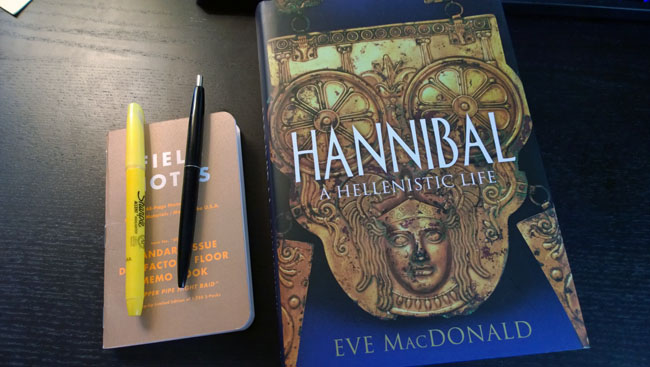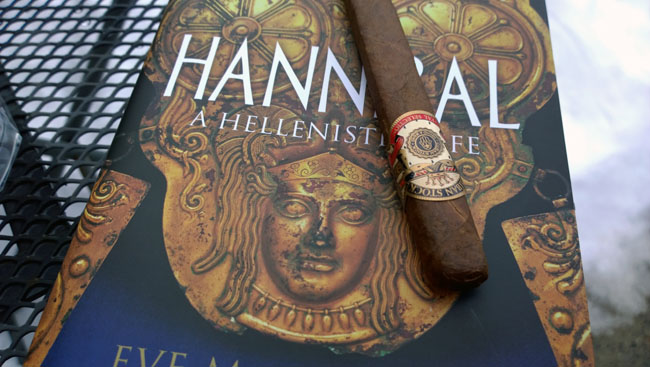
MacDonald, Eve. Hannibal: A Hellenistic Life. New Haven: Yale University Press, 2015. Pp. 323. ISBN 978-0-300-15204-3. $38.00.
Using the prisms of the Roman perspective and the Hellenistic world (chapter 1), Eve MacDonald crafts a narrative that follows Rome and Carthage through the First Punic War and Carthage’s own civil war (chapter 2), the rise of Hannibal Barca’s father in Spain (chapter 3), and eventually Hannibal’s own rise to power (chapter 4). These chapters provide the reader with the necessary context for the start of the Second Punic War and the Hellenistic world that heavily influenced commanders of the day. MacDonald, archaeologist and lecturer at the University Reading, points out that the Hellenistic kingdoms “established their legitimacy through military victory” (25) and men such as Alexander, Agothocles, Pyrrhus, and Xanthippus provided perfect examples for the likes of Hannibal. This also meant that armies relied heavily on mercenaries (35) and victors often avoided total annihilation of opponents (134). As for the Roman perspective, MacDonald maintains a critical eye. With the destruction of Carthage, the Romans owned the history of the city and its people. As such, the author points out that the oft told stories of the Barcid hatred for the Romans was likely a “literary construct” to justify later destruction of Carthage (62).
As for crossing the Alps (chapter 5), MacDonald heaps the usual praise on Hannibal’s “brilliance” for “chang[ing] the paradigm of the war before it had begun” (85). The more interesting aspect of her analysis is on Hannibal’s “myth management” or propaganda (88), as he adopted the image of the Phoenician god Melqart whose Greek counterpart—Heracles—trekked a similar path. MacDonald presents another prism utilized throughout the book—Hannibal’s relationship with his troops. In addition to maintaining a divine, heroic image, Hannibal and other successful Hellenistic commanders engendered “direct and immediate loyalty” (89). MacDonald drives this point home throughout the book, especially to explain how Hannibal’s army did not disintegrate at its lowest points before vacating Italy.
MacDonald covers the battles of Ticinus, Trebia, and Trasimene in a single chapter (chapter 6), which is indicative of the lack of battle analysis throughout the book. There are no battle maps whatsoever. The descriptions are high-level with no thought given to the logistics of cleaning up tens of thousands of bodies on a field. There is no “face of battle” from MacDonald, as the only horror of war comes straight from the pages of Polybius and Livy. Instead, MacDonald focuses on leadership structures and reinforcements. This is where MacDonald excels, as she states and then clearly demonstrates the “war for Italy would be won by the allies” (104). Here and throughout the rest of the book, MacDonald describes how Hannibal was lenient on all of Rome’s allies after a battle while trying to woo their cities to his cause.
After Hannibal’s crushing success at Cannae (chapter 7), MacDonald tackles the age-old question of why the victorious general did not march on Rome. It was 400 kilometers away for one thing, a lengthy march for even a fresh army. In addition, the tradition of the Hellenistic world was to end a war after a battlefield victory, which explains why Hannibal “believed the Romans would sue for peace” (134). Finally, MacDonald argues Hannibal’s previous siege experiences had soured him on attacking any well-fortified city (76).
If anyone wants to understand why Hannibal did not conquer Italy after so many crushing battle victories, then chapters 8 and 9 are worth the price of the book. MacDonald meticulously analyzes the city-states throughout Italy, as the “battle for the hearts and minds of the Italian allies of the south was thus won or lost one city at a time” (141). Each city had its own ruling elite, typically a family, while there was a lesser family vying to gain power. Hannibal had to convince each city that he would win the war and provide a type of freedom the people actually desired. Most stayed with the Romans while some of the cities Hannibal brought into this alliance (e.g., Capua) deterred other would-be allies.
After Cannae, the Romans adopted Fabius Maximus’s strategy (with a few exceptions), shadowing and harassing Hannibal, but never confronting. Hannibal still expanded his powerbase to the city of Tarentum, but it was 300 kilometers from Capua. The distance was a factor and “so much of the war relied on his personal command that [Hannibal] found himself stretched across the south of Italy” (166). MacDonald describes how the Romans learned to use their superior manpower to slowly strip away Hannibal’s cities (161) while also engaging in “myth management” of their own to build up their own heroic general, Scipio (176). Here, MacDonald’s narrative moves past Italy, focusing heavily on the events in Spain and Syracuse where the Carthaginians and their allies suffered significant setbacks.
Rome’s methodical Fabian strategy had already severely diminished Hannibal’s threat by 207 BC (188). With the destruction of the only reinforcements to arrive in Italy (chapter 10), MacDonald believes the Carthaginian threat was over in Italy (192). Hannibal possibly stayed in Italy with no chance of success as a potential strategy by Carthage to keep Rome out of Africa (183), but more likely because of Hannibal’s commitment to his army and allies (196). This is all pure conjecture as the ancient sources are vague on any such strategy, but MacDonald presents her theories clearly.
After Scipio conquered Spain and invaded Africa (chapter 11), Hannibal was contained in Italy while Scipio racked up victories over Carthage (209). When the two generals finally met at Zama, victory for Hannibal “had never been very likely for he had fought with a vastly inferior army” (216). MacDonald emphasizes the Roman perspective, as Scipio and later historians perfected their “myth management.” As such, “for Scipio Africanus to be considered a military genius it required that Hannibal be a worthy adversary, a foe equal to the conqueror” (230). Thus, Zama was a great victory. MacDonald provides a cursory historiography in her epilogue, which is just enough for the reader to appreciate that “it was the reputation and celebrity of Hannibal, even more than those of his Roman foes, that flourished in the Roman world and beyond” (230).
For a book by an archaeologist, there is surprising little archaeology, or at least mention of it. MacDonald briefly covers the newly discovered Baecula battlefield in Spain (184), as well as hordes of Hannibalic coins in Bruttium (196), but the author could have greatly enriched her work with her archaeological expertise.
As far as books about Hannibal, MacDonald has produced a work in a completely new class. The emphasis on the Hellenistic tradition of rulers is by no means unique, but the chapters on Hannibal’s efforts to woo allies provide a real explanation as to why battlefield victories alone could not win the war in Italy. MacDonald even recognizes the lack of drum and trumpets in her battle descriptions, recommending other works with battle maps (e.g., Hannibal’s War: A Military History of the Second Punic War). Instead, MacDonald has focused heavily on leadership structures, Italian allies, religion, propaganda, and the bias of the sources. More importantly, she provides overwhelming context for the conflicts between Carthage and Rome, and the beginning of the Punic Wars.
Hannibal: A Hellenistic Life is a must-read for anyone interested in Hannibal and the Punic Wars.

